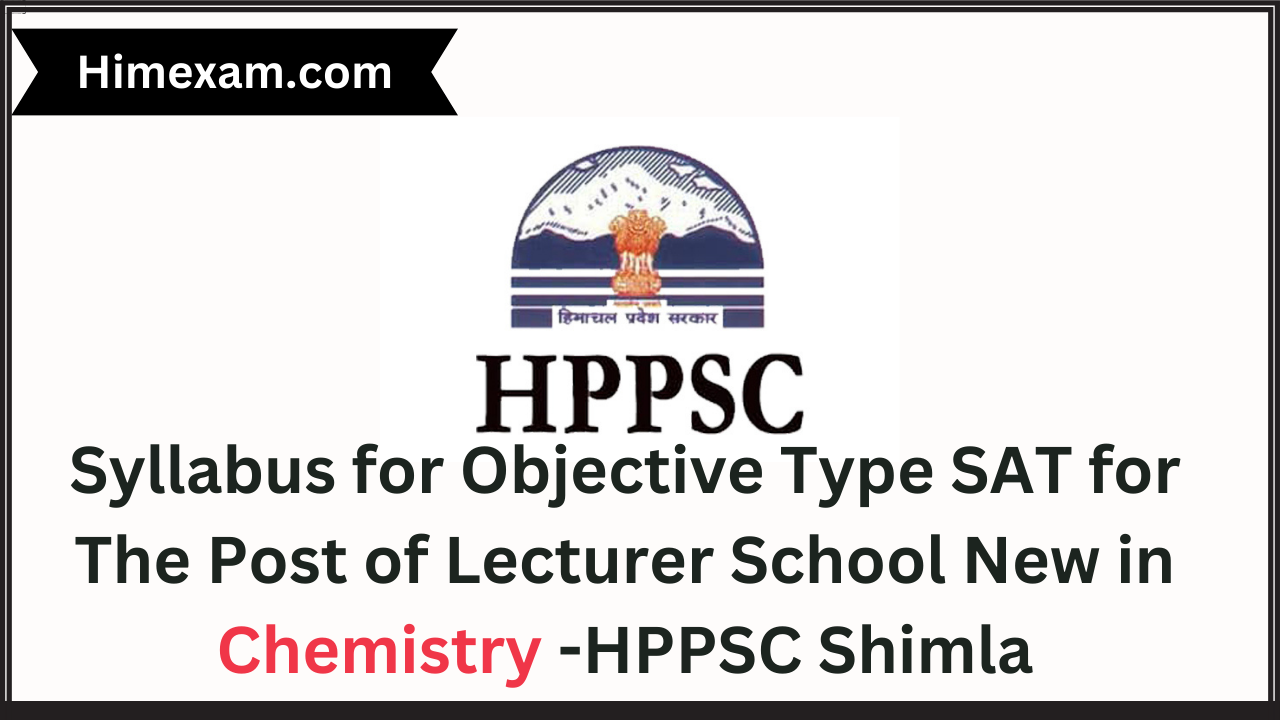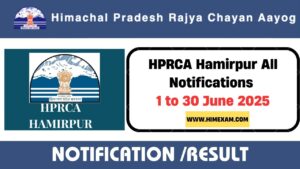Syllabus for Objective Type SAT for The Post of Lecturer School New in Chemistry -HPPSC Shimla
COMMON SYLLABUS FOR OBJECTIVE TYPE SUBJECT APTITUDE TEST (SAT) FOR RECRUITMENT TO POST OF LECTURER (SCHOOL NEW) IN CHEMISTRY, CLASS-III IN THE DEPARTMENT OF HIGHER EDUCATION. THIS PAPER WILL BE OF 02 HOURS DURATION OF 100 MARKS. THE OBJECTIVE TYPE SUBJECT APTITUDE TEST (SAT) SHALL COVER FOLLOWING TOPICS:
Syllabus for Objective Type SAT for The Post of Lecturer School New in Chemistry -HPPSC Shimla
PART-I (Subject) 80 marks
1.INORGANIC CHEMISTRY: Group theory: The concept of group, Symmetry elements and symmetry operations, Assignment of point groups toInorganic molecules, some general rules for multiplications of symmetry operations, Multiplication tables for water andammonia, Representations (matrices, matrix representations for C2V and C3V point groups irreducible representations), Character and character tables for C2V and C3V point groups. Applications of group theory to chemical bonding (hybrid orbitals for σ-bonding in different geometries and hybrid orbitals for π-bonding. Symmetries of molecular orbitals in BF3, C2H4 and B2H6., Non-Aqueous Solvents: Factors justifying the need of Non-Aqueous solution Chemistry and failure of water as a Solvent. Solution chemistry of Sulphuric acid: Physical properties, Ionic selfdehydration in H2SO4, high electrical conductance inspite of high viscosity, Chemistry of H2SO4 as an acid, as a dehydrating agent, as an oxidizing agent, as a medium to carryout acid-base neutralization reaction and as a differentiating solvent. Liquid BrF3: Physical properties, solubilities in BrF3, self-ionization,acid base neutralization reactions, solvolytic reactions and formation of transition metalfluorides, Inorganic Hydrides: Classification, preparation, bonding and their applications. Transition metal compoundswith bondsto hydrogen, carbonyl hydrides and hydride anions. Classification, nomenclature, Wade‘s Rules, preparation, structure and bonding in boronhydrides (boranes) and carboranes, Chelation, factors determining the stability of chelates (effect of ring size, oxidation state of themetal, coordination number of themetal); Organic Reagents in Inorganic Chemistry: Use of the following reagents in analysis: Dimethylglyoxime (in analytical chemistry), EDTA (in analytical chemistry and chemotherapy), 8-Hydroxyquinoline (in analytical chemistry and chemotherapy), 1, 10-Phenanthroline (in analytical chemistry and chemotherapy), Thiosemicarbazones (in analytical chemistry and chemotherapy), Dithiazone (in analytical chemistry and chemotherapy). Metal-Ligand Bonding-I: Recapitulation of Crystal Field Theory including splitting of d-orbitals in different environments, Factors affecting the magnitude of crystal field splitting, structural effects (ionic radii, Jahn-Teller effect),Thermodynamic effects of crystal field theory (ligation, hydration and lattice energy), Limitations of crystal field theory, Adjusted Crystal Field Theory (ACFT), Evidences for Metal-Ligand overlap in complexes, Molecular Orbital Theory foroctahedral, tetrahedral and square planarcomplexes (excluding mathematical treatment). Atomic Spectroscopy: Energy levels in an atom, coupling of orbital angular momenta, coupling of spin angular momenta, spin orbit coupling, spin orbit coupling p2 case, Determining the Ground State Terms-Hund’s Rule, Hole formulation (derivation of the Term Symbol for a closed sub-shell, derivation of the terms for a d2 configuration), Calculation of the number of themicrostates, Electronic Spectra-I: Splitting of spectroscopic terms (S,P,D.F and G,H,I), d1 -d 9 systems in weak fields (excluding mathematics), strong field configurations, transitions from weak to strong crystalfields, Electronic Spectra-II: Correlation diagrams (d1 -d 9 ) in OhandTd environments, spin-crossoverin coordination compounds. Tanabe Sugano diagrams, Orgeldiagrams, evaluation of B,C and β parameters. Magnetochemistry: Origin of Magnetic moment, Magnetic susceptibility (diamagnetic, paramagnetic), spin only moment, Russell Saunder’s coupling, quenching of orbital angular moment, orbital contribution to a magnetic moment, 2 magnetic moments from magnetic susceptibilities, temperature dependence of magnetic susceptibility, Factors determining paramagnetism, application of magnetochemistry in coordination chemistry in spin free and spin paired octahedral and tetrahedral complexes, Van Vlecks formula formagneticsusceptibility, Metal π Complexes: Preparation, reactions, structures and bonding in carbonyl, nitrosyl and phosphine complexes, structural evidences from vibrational spectra. Structure and bonding in metal cyanides, stabilization of unusual oxidation states of transition metals, Introductory Photoelectron Spectroscopy: Basic principle, photoionization process, ionization energies, Koopman‘s theorem, ESCA, photoelectron spectra of simple molecules, (N2, O2) Photoelectron spectra for the isoelectronic sequence Ne, HF, H2O, NH3and CH4 , chemical information from ESCA, Augerelectronspectroscopy–basic idea, Lanthanides and Actinides:- Spectral and magnetic properties, comparison of Inner transition and transition metals, Transuranium elements (formation and colour of ions in aqueous solution), uses of lanthanide compounds as shift reagents, periodicity of translawrencium elements.
2. ORGANIC CHEMISTRY: Stereochemistry: Introduction to Basic Concepts of Stereochemistry: Isomers and their properties, Threo and Erythroisomers, Chirality, Optical isomerism, Geometrical isomerism, Conventions for configurations- D, L and R, S systems, Racemic mixture and Racimization, Resolution of Racemic mixtures, Measurement of optical activity, optical purity, Streoselective and Streospecific reactions, epimerization, epimers, anomers and mutarotation, Axial Chirality (Allenes and Biphenyls), Planar chirality, Helicity, Chirality involving atoms other than carbon atoms, Prochirality: prostreoisomerism and Asymmetric synthesis, Conformational and streoisomerism of acylic and cylic systems, cyclohexane, decalins, effect of conformation on reactivity in a cylic and cyclohexane systems, Reaction Mechanism: Structure and Reactivity: Thermodynamic and kinetic requirements, Kinetic and Thermodynamic control, Hammondspostulate, Curtin-Hammett principle. Potential energy diagrams, transition states and intermediates, Effect of structure on reactivity: resonance and field effects, steric effect. Quantitative treatment: Hammett equation and linear free energy relationship, Substituent and reaction constants, Taftequation. Methods of determining Reaction mechanisms, Aliphatic Nucleophilic Substitution: Reactivity effect of substrate structure, leaving group and nucleophile. The SN2, SN1, mixed SN1 and SN2, SET mechanisms & SNi mechanism. The neighboring group mechanism, neighboring group participation by π and σ bonds, anchimeric assistance. Non-classical carbocations, phenoniumions, norbornyl system, common carbocation rearrangements- Wagner-Meerwein, Pinacol-Pinacolone and Demjanov ring expansion and ring contraction. Nucleophilic substitution at an allylic, aliphatic trigonal and a vinyliccarbon. Esterification of carboxylic acid, transesterification, Phase-transfer catalysis, and ultrasound, ambident nucleophile, regioselectivity. Free radical reactions: Geometry of free radicals, Types of free radical reactions, free radical substitution mechanism, mechanism at an aromatic substrate neighboring group assistance, Reactivity in aliphatic and aromatic substrates at abridgehead and attacking radicals. Effect of solvents on reactivity. Allylic halogenation (NBS), oxidation of aldehydes tocarboxylic acids, auto oxidation, coupling of alkynes and arylation of aromatic compounds by diazonium salts (Gomberg Bachmannreaction), Hoffmann-LofflerFreytagreaction, Hunsdieckerreaction. Elimination Reactions: Discussion of E1, E2, E1cB and E2C Mechanisms and orientation, Reactivity: Effects of substratestructures, attacking base, leaving group and medium. Mechanism and Orientation in Pyrolytice liminations, Ciselimination, elimination in cyclic systems, eclipsing effects, cleavage of quaternary 3 ammonium hydroxides, Shapiroreaction, Conversion of Ketoxime tonitriles. Aromatic Electrophilic Substitution: Arenium ion mechanism, orientation and reactivity, The ortho/para ratio, ipsoattack, orientation in other ring systems. Quantitative treatment of reactivity in substrates and electrophiles, Diazoniumcoupling, Vilsmeir – Haack reaction, Scholl reaction, Amination reaction, Fries rearrangement, Hofmann-Martius Reaction,ReversalofFriedel Craftalkylation, Aromatic Nucleophilic Substitution: SNAr, SN1, benzyne and SRN1 mechanism. Reactivity, effect of substratestructure, leaving group and attacking nucleophile, Von Richter, Sommelet-Hauser, and Smiles rearrangements, Ullmanreaction, Ziegleralkylation, Schiemannreaction, Common Organic Reactions and Their Mechanisms: Perkin condensation, Michael reaction, Robinson annulation, Diekmann reaction, Stobbe condensation, Mannich reaction, Knoevenagel condensation, Benzoin condensation, Wittingreaction, Hydroboration, Hydrocarboxylation, Esterhydrolysis, Epoxidation, Reagents in Organic Synthesis: Synthesis and applications of BF3, NBS, Diazomethane, Lead tetra-acetate, Osmiumtetra oxide, Woodward Prevorsthydroxylationre agent, LiAlH4, Grignardreagent, organozincandorganolithiumre agent, Pericyclic Reactions: Molecular orbital symmetry, Frontier orbitals of ethylene, 1,3-butadiene, 1,3,5 hexatrienes and allylsystem. Classification of pericyclic reactions,Woodward-Hoffmanncorrelation diagrams. FMO and PMO approach. Electrocyclic reactions: conrotatory and disrotatory motions, 4n and 4n+2 and allyl systems. Cycloadditions- antarafacialand suprafacial additions, 4n and 4n+2 systems, 2+2 addition of ketenes, 1,3 dipolar cycloadditions and chelotropicreactions. Sigmatropicrearrangements-Suprafacial and Antarafacial shifts of H, sigmatropic shifts involving carbonmoieties. Ultra Violet and Visible Spectroscopy: Electronic transitions (185-800 nm), Beer- Lambert Law, Effect of solvent onelectronic transitions, Ultra Violet bands of carbonyl compounds, unsaturated carbonyl compounds, dienes, conjugated polyenes, Steric effect in biphenyls, Fieser- Woodward rules for conjugated dienes and carbonyl compounds, ultra violet spectra of aromatic and heterocyclic compounds.. Applications of UV- visible spectroscopyin organic chemistry. Infrared Spectroscopy: Principle, Instrumentation and sample handling, Characteristic vibrational frequencies of common organic compounds, Effect of hydrogen bonding and solvent effect on vibrational frequencies, overtones, combination bands and Fermi resonance. Nuclear Magnetic Resonance (NMR) spectroscopy General introduction, chemical shift, spin-spin interaction, shielding mechanism, chemical shift values and correlation of protons present in different groups in organic compounds. Chemical exchange, effect of deuteration, complex spin-spin interaction between two, three, four and five nuclei, virtual coupling. Stereo chemistry, hindered rotation, Karplus- relationship of coupling constant with dihedral angle. First and second order spectra, Simplification of complex spectra-nuclear magnetic double resonance, spintickling, INDOR, contact shiftre agents, solvent effects. Fourier transform technique, nuclear Overhauser effect (NOE). Mass Spectrometry: Introduction, ion production EI, CI, FD and FAB, factors affecting fragmentation, ion analysis, and ionabundance. Mass spectral fragmentation of organic compounds with common functional groups, Molecular ionpeak, Meta-stablepeak, McLafferty rearrangement. Nitrogen Rule. Examples of mass spectral fragmentation of organic compounds with respect to their structure determination. Problems based upon IR, UV, NMR and mass spectroscopy, Photochemistry–I: Introduction and Basic principles ofphotochemistry. Interaction of electromagnetic radiations with matter, Types of excitations, fate of excited molecules, quantum yield, transfer of excitation energy, actinometry. Photochemistry of alkenes: cistrans isomerization, dimerization of alkenes, photochemistry of conjugated olefins, photooxidation of alkenes and polyenes Photochemistry of Aromatic compounds: Isomerization, addition and substitution, photo-reduction of aromatic hydrocarbons, Photochemistry – II: Photochemistry of Carbonyl compounds: Norrish Type I and II, Intermolecular and 4 Intramolecularhydrogen abstraction, Paterno-Buchi reaction, α and β- cleavage reactions of cyclic and acyclic carbonyl compounds, Formation of oxetane and cyclobutane from α,β unsaturated ketones, Photo-reduction of carbonyl compounds, Photo-rearrangement of enones, dienones, epoxyketones, Photo Fries rearrangement.
3.PHYSICAL CHEMISTRY: Resonance Spectroscopy: Principle and Theory of nuclear magnetic resonance (NMR). Chemical shift and spin – spincoupling. Factorsinfluencing chemical–shift and spin– spin coupling of 1H-NMR. Spin –spin andspin– latticerelaxation processes. Line –width and rate processes. First and second order 1H-NMR spectra. Principle and theory ofElectronSpinResonance(ESR). Hyperfine structure of ESR. Zero–field splitting of ESR signal., Mc Connellrelation. Introduction to Mossbaurspectroscopy (isomer–shift, quadrupoleinteraction and magnetic hyperfine interaction), Molecular Spectroscopy: Rotational spectra of non–rigid diatomic molecules and symmetric-top molecules. Anharmonic oscillator, overtones and hot bands. Diatomic vibrator– rotator (P, Q and R – branches). Rotational–vibrational spectra of symmetric– top molecules. Raman Spectroscopy. Rotational and vibrational Raman spectra of linearand symmetric topmolecules, overtones and mutual exclusion principle, Kinetics of complex reactions: Consecutive and competitive (parallel) first order reactions. Kinetic vs. Thermodynamic control reaction. Free radical reactions; thermal (H2 – Br2) and photochemical (H2 –Cl2) reactions. Rice – Herzfeld mechanism of dissociation of organic molecules viz. dissociation of ethane, decomposition of acetaldehyde as 3/2 or ½ order reactions. Reaction rates and chemical equilibrium, principle of microscopic reversibility, activation energy and activated complex, Transition state theory and its kinetic and thermodynamic formulation. Introduction to Potential energy surfaces. Kineticsin solutions: diffusion controlled reactions, their rates and influence of the solvent. Collisions and transition state theories in simple gas reactions, Lindmann and Hinshelwood treatment, Catalytic activity at surfaces: adsorption and catalysis, the Langmuir–Hinshelwood mechanism, the Eley–Rideal mechanism. Examples of catalysis: hydrogenation, oxidation and cracking and reforming (qualitative treatment only). Introduction to fast reactions. Flash photolysis and Stopped flow methods to study the kinetics of fast reactions, Chemical Thermodynamics-I: Brief resume of laws of thermodynamics, Freeenergy functions, Gibbs and Helmholtz free energy functions and their significance, Gibbs-Helmholtz equation, thermodynamic equilibria and free energy functions, applications of GibbsHelmholtzequation, Clapeyron-Clausius equation, Thermodynamics of Elevation in boiling point, depression in freezing point, relation between osmotic pressure and elevation of boiling point, relationbetweenosmotic pressure and depressionin freezing point, Chemical Thermodynamics-II: Chemical affinity, applications of chemical affinity, methods for determining the chemical affinity, partial molar properties, Physical significance of partial molar properties, chemical potential, Gibbs -Duhem equation, variation of chemical potential with temperature and pressure, chemical potential of a pure solid or liquid, chemical potential of a pure ideal gas and mixture of ideal gases, thermodynamic functions of mixing, fugacity, fugacity coefficient, determination of fugacity, variation of fugacity with temperature and pressure, Lewis Randall rule, Duhem-Margulesequation, activity, activity coefficient, determination of activity and variation with temperature and pressure, Nernst heat theorem and third law of thermodynamics and its application. Thermodynamic derivation of phase rule and its application to two component systems. Distribution law, its thermodynamic derivation and application. Non–Equilibrium Thermodynamics: Basic principles of non – equilibrium thermodynamics: Rate laws, second law of thermodynamics for open system, law of conservation of mass, charge and energy flow, electrokinetic phenomena and expressions 5 for streaming potential, electro-osmotic pressure difference, streaming potential using the linear phenomenological equation, Colloidal State: Classification of colloids, charge and stability of colloidal dispersions, Hardy-Schulze Law, gold number,electrical properties of colloids, electrical double layer and its structure, Stern’s theory of double layer, zetapotential, electrophoresis and electro-osmosis, emulsions and their classification, emulsifiers, gels and their classification, Statistical Thermodynammics: Basic Terminology: probability, phasespace, micro and macrostates, thermodynamic probability, statistical weight, assembly, ensemble, The most probable distribution: Maxwell-Boltzmann distribution, quantum statistics: The Bose-Einstein statistics and Fermi- Dirac Statistics. Thermodynamic probability (W) for the three types of statistics. Lagrange’s undetermined multipliers. Stirling’s approximation, Molecular partition function and its importance, Applications to ideal gases: The molecular partition function and its factorization. Evaluation of translational, rotational and vibrational partition functions, the electronic and nuclearpartition functions. formonatomic, diatomic and polyatomicgases, Thermodynamic properties of molecules from partition function: Totalenergy, entropy, Helmholtz freeenergy, pressure, heat content, heat capacity and Gibb’s free energy, equilibrium constant and partition function, Heat capacity of crystals and statistical thermodynamics, Third law of thermodynamics and entropy. Ortho- and para-hydrogen, statistical weights of ortho and para states, symmetry number. Calculation of equilibrium constants of gaseous solutions in terms of partition function, Einstein theory and Debye theory of heat capacities of monatomic solids.
4. APPLICATION OF BIOCHEMISTRY TO BIOTECHNOLOGY: Micro methods in Protein Chemistry, Isolation of peptides for Sequence analysis, Peptide mapping, chemical and enzymatic hydrolysis of proteins, Extraction and fractionation of RNA and DNA, Isolation of plasmids, plasmid derived vectors, phages and yeast vectors, Enzymes involved in recombinant DNA technology, Genomic and cDNA library, Ti plasmid as tool for genetic engineering in plants, Bacterial transformation screening of transformants, N-labelling, Random labelling of nucleic acid probes, Nick translation, hybridization and blotting techniques dot blot Northern and Southern blot, South-Western blot analysis, biotinavidin system, applications in detection of bio-molecule, Techniques to study DNA protein interaction, Transgenic animals and plants, Knockout animals, Chemical synthesis of oligo nucleotides, Polymerase Chain Reaction (PCR), Basic principle, method, Variations of PCR, Amplification of specific DNA fragments, Applications in medicine and forensic sciences, Techniques to detect polymorphism RAPD, RFLP, AFLP etc. DNA based diagnosis of genetic disorders, Recombinant DNA technology in medicine and industry, In situ hybridization, gene therapy, Monoclonal Antibodies and Vaccines, Definition and nature of monoclonal antibodies (MCA), Antigen preparation for MCA production, Methodolgy producing MCA, Immunization and generation of immune response, Myleoma cells for hybridization, cell fusion and selection of hybrids using HAT medium, Cloning and isolation of hybrid cell lines, In vitro and in vivo culture of hybrid cell lines, Screening of specific MCA, Purification and labelling of MCA, uses and applications of MCA, T-cell hybridomas and their applications, Vaccines (subunit, live recombinant, attenuated and DNA Vaccines).
5. CLINICAL BIOCHEMISTRY: Diagnostic Enzymes-enzyme assay in serum/plasma, urine and cells, clinically important enzymes, use of isoenzymes in diagnosis Organ functions tests, Assessment and clinical manifestation of hepatic, renal, gastrointestinal and pancreatic functions, Disorders of Metabolism, Carbohydrates, Diabetes mellitus, Glycogen Storage diseases, Galactosemia, 6 pentosuria, Amino Acids- Disorders of glycine, sulphur containing amino acids, aromatic amino acids, histidine, branched chain amino acids and proline, disorders of propionate and methylmalonate metabolism, Disorders in urea biosynthesis, Lipids, Hyper lipoproteinemia, Abetalipoproteinemia, Hyperlipidemia, Tay-Sachs Disease (Gangliosidosis), Neimann Pick Disease, Gaucher’s Disease, Krabb’s Disease, Metachormatic leukodystrophy and Fabry’s Disease, Wolman’s Disease, Disorders of porphyrin and heme metabolism, Disorders in purine and pryimidine metabolism, Myocardial infarction and atherosclerosis, Electrolytes and acid-base balance, regulation of electrolyte content of body fluid and maintenance of pH, Disorders of electrolyte, Water and acid-base balance, Quality control in Clinical Biochemistry.
6. BIOCHEMICAL TOXICOLOGY: Definition, scope and relationship of Toxicology to other sciences, Nature of toxic effects, Acute and chronic exposure, Dose response relationship, Determination of LD-50, no observed effect level (NOEL), acceptable daily intake, bioavailability, volume of distribution, plasama half life, total body burden, total body clearance Synergism and Antagonism, Metabolism of Toxicant-Introduction, absorption and distribution Cytochorome P-450, MFO system and their role in xenobiotics metabolism, Non-microsomal oxidation, Phase-I and Phase-II reactions, conjugations, Glucoronide conjugates, Conjugations catalysed by sulfotransfereases, methyl transferases and acetyl transferases Glutathinoe conjugation and Amino Acid conjugations, Toxicity Testing and Target organ toxicity, Ames test, Host mediated assay and dominant lethal test, Drosophilla sex linked recessive lethal test, micronucleus test, Toxicology of Medical devices, Haemotoxicology, Hepatotoxicity. 7. MOLECULAR CELL BIOLOGY: Cell Cycle, Cell cycle control system, cell cycle events in S. pombe, S. cerevisae, and mammalian system, M phase kinase, protein phosphorylaiton and dephosphorylation p34 as key regulator in yeast, CDC 28, function of CDK-cyclin complex, CDK inhibitors, reorganization of the cell at mitosis, Apoptosis and cell proliferation, Extrinsic and intrinsic pathways of apoptosis, techniques to analyze apoptosis, molecular basis of cancer, multistep carcinogenesis, signal transduction and cancer, tumor suppressor genes and proto-oncogenes and oncogenes, tumor causing viruses, DNA viral genes, Retroviral-associated oncogenes in growth regulation, strategies for cancer prevention and cure, Signaling molecule and cell surface receptors, Intracellular signal transduction, second messengers, protein functioning as signal transducers, localization of receptors and signal transducers, G-protein coupled receptors and downstream signalling, TGF receptors and activation of Ras, Raf, MAP kinase signalling, phosphomositide as signal transducer, pathways that involve signal induced protein cleavage (NF-KB and NOTCH), Hedge hog and wnt signalling pathways (Classical and non classical) down regulation of receptor signalling, Specialized tissues and stem cells, Renewal of epidermis, sensory epithelia, airways and the gut, blood vessels, multi potent stem cells, connective tissue cell family, stem cell engineering.
Part-II (B.Ed. portion) 20 marks
Foundation of Education System
- Concept and Nature of Knowledge, Knowledge Acquiring Process.
- Indian Knowledge System; Vedic Education System, Buddhist Education System
- Concept of Education; Meaning, Nature, Modes of Education, Objectives of Education,
- Approaches to Education.
- Philosophical, Psychological, Sociological and Technological Basis of Education
- (Meaning and Needs)
- Concept of important Variables: Personality, Intelligence, Creativity, Academic
- Achievement, Problem Solving Ability
Teacher Education and Related Aspects:-
- Concept of Teacher Education, Historical Aspects of Teacher Education in India, Scope of Teacher Education, Types and Levels of Teacher Education Programmes.
- Teacher and Teaching related Concepts, Learner and Learning Related Concepts,
- Relation between Teaching and Learning, Learning Environment, Pillars of Learning.
- Challenges in the field of Teacher Education (Discussion with reference to NEP 2020 also)
Pedagogy and Teaching Learning Experiences:-
- Communication Skills and its Use
- Models of Teaching; Advance organizer, Concept Attainment, Information Processing, Inquiry Training
- Methods of Teaching
- Preparation and Use of Teaching Learning Material
Information Technology in Teaching Learning Process
- ICT; Its meaning and use in Teaching Learning Process
- Concept of Open Educational Resources, SWAYAM and MOOCs
- Digital Initiatives in School Education by Government of India
More Pages:-
हेलो दोस्तों ,आपका हमारी वेबसाइट Himexam.com पर स्वागत है। जैसा की आपको पता है हमारी वेबसाइट Himexam.com आपको समय-समय पर सभी HP Govt Jobs & All India Govt Jobs की Notifications प्रदान करवाती है। साथ ही साथ Himachal Pradesh Exam Previous Paper और Himachal Pradesh GK ,Himachal Pradesh & National +International Current Affairs के सभी नोट्स मुफ्त उपलब्ध करवाते है। हमारी वेबसाइट के अलग अलग प्लेटफार्म पर pages & Group बने है जैसे की facebook ,Telegram और Instagram .. अगर आप हिमाचल के किसी भी पेपर की तैयारी कर रहे हो तो जल्दी से इन groups के साथ जुड़ जाएं इनके लिंक नीचे table में दिए गए है।
Join Us:-
| Like Our Facebook Page | Click here |
| Join Us oN Telegram | Click here |
| Join Us On Instagram | Click Here |








